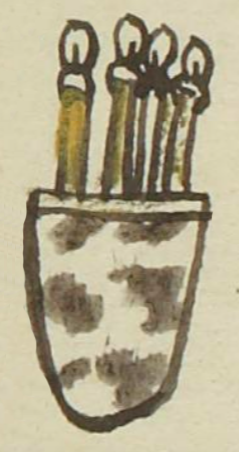Mical (MH524r)
This black-line drawing of the compound glyph for the personal name Mical ("He Skirmishes") shows a frontal view of four or five arrows (mitl) in a housing (perhaps calli) that Westerners would call a quiver. The arrows are vertical and decorated with feathers. Their shafts are yellow, suggesting that they are made from reeds (acatl). The housing or case for the arrows covers the lower half of the arrows. It is rounded at the bottom. It appears to be made from animal hide, perhaps a jaguar skin, as it has spots on it.
Stephanie Wood
To skirmish is micali, and a warrior who was constantly in battle was known as a micalini. We have yet to find micalli translated as quiver, but it is a possibility. But micomitl is attested as quiver. For the moment, we are declaring this fully phonographic, given that the element might only semantically point to the verb to skirmish.
Stephanie Wood, with assistance from Gordon Whittaker
domigo mical
Domingo Mical
Stephanie Wood
1560
Stephanie Wood
carcajes, aljabas, quivers, arrow containers, feathers, plumas, nombres de hombres

mi(tl), arrows or darts, https://nahuatl.wired-humanities.org/content/mitl
cal(li), house, building, container, https://nahuatl.wired-humanities.org/content/calli
micali, to skirmish, https://nahuatl.wired-humanities.org/content/micali
micomi(tl), quiver, https://nahuatl.wired-humanities.org/content/micomitl
micalini, a warrior, constantly in battle, https://nahuatl.wired-humanities.org/content/micalini
Flecha-Carcaj
Stephanie Wood
Matrícula de Huexotzinco, folio 524r, World Digital Library, https://www.loc.gov/resource/gdcwdl.wdl_15282/?sp=127&st=image.
This manuscript is hosted by the Library of Congress and the World Digital Library; used here with the Creative Commons, “Attribution-NonCommercial-ShareAlike 3.0 License” (CC-BY-NC-SAq 3.0).




